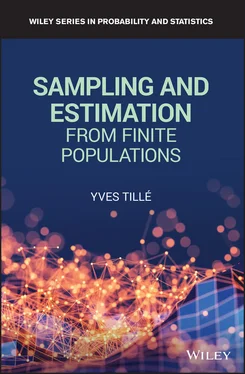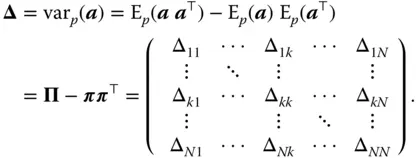Yves Tille - Sampling and Estimation from Finite Populations
Здесь есть возможность читать онлайн «Yves Tille - Sampling and Estimation from Finite Populations» — ознакомительный отрывок электронной книги совершенно бесплатно, а после прочтения отрывка купить полную версию. В некоторых случаях можно слушать аудио, скачать через торрент в формате fb2 и присутствует краткое содержание. Жанр: unrecognised, на английском языке. Описание произведения, (предисловие) а так же отзывы посетителей доступны на портале библиотеки ЛибКат.
- Название:Sampling and Estimation from Finite Populations
- Автор:
- Жанр:
- Год:неизвестен
- ISBN:нет данных
- Рейтинг книги:4 / 5. Голосов: 1
-
Избранное:Добавить в избранное
- Отзывы:
-
Ваша оценка:
Sampling and Estimation from Finite Populations: краткое содержание, описание и аннотация
Предлагаем к чтению аннотацию, описание, краткое содержание или предисловие (зависит от того, что написал сам автор книги «Sampling and Estimation from Finite Populations»). Если вы не нашли необходимую информацию о книге — напишите в комментариях, мы постараемся отыскать её.
Sampling and Estimation from Finite Populations Provides an up-to-date review of the theory of sampling Discusses the foundation of inference in survey sampling, in particular, the model-based and design-based frameworks Reviews the problems of application of the theory into practice Also deals with the treatment of non sampling errors
is an excellent book for methodologists and researchers in survey agencies and advanced undergraduate and graduate students in social science, statistics, and survey courses.

 is a function of the values
is a function of the values  that are observed on the random sample:
that are observed on the random sample:  . This statistic takes the value
. This statistic takes the value  on the sample
on the sample  . The expectation under the design is defined from the sampling design:
. The expectation under the design is defined from the sampling design:

 is the probability that unit
is the probability that unit  is selected in the sample. This probability is, in theory, derived from the sampling design:
is selected in the sample. This probability is, in theory, derived from the sampling design:
 . In sampling designs without replacement, the random variables
. In sampling designs without replacement, the random variables  have Bernoulli distributions with parameter
have Bernoulli distributions with parameter  There is no particular reason to select units with equal probabilities. However, it will be seen below that it is important that all inclusion probabilities be nonzero.
There is no particular reason to select units with equal probabilities. However, it will be seen below that it is important that all inclusion probabilities be nonzero. is the probability that units
is the probability that units  and
and  are selected together in the sample:
are selected together in the sample:
 In sampling designs without replacement, when
In sampling designs without replacement, when  , the second‐order inclusion probability is reduced to the first‐order inclusion probability, in other words
, the second‐order inclusion probability is reduced to the first‐order inclusion probability, in other words  for all
for all 
 is denoted by
is denoted by





 is a variance–covariance matrix which is therefore semi‐definite positive.
is a variance–covariance matrix which is therefore semi‐definite positive.
 is not random. In this case, the sum of the inclusion probabilities is exactly equal to the sample size.
is not random. In this case, the sum of the inclusion probabilities is exactly equal to the sample size.
 be a column vector consisting of
be a column vector consisting of  ones and
ones and  a column vector consisting of
a column vector consisting of  zeros, the sample size can be written as
zeros, the sample size can be written as  . We directly have
. We directly have










